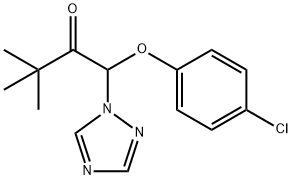1-(4-클로로페녹시)-3,3-다이메틸-1-(1H-1,2,4-트리아졸-1-일)-2- 부타논
|
|
1-(4-클로로페녹시)-3,3-다이메틸-1-(1H-1,2,4-트리아졸-1-일)-2- 부타논 속성
- 녹는점
- 82°C
- 끓는 점
- 441.9±55.0 °C(Predicted)
- 밀도
- 1.2200
- 증기압
- 2 x l0-5 Pa (20 °C)
- 굴절률
- 1.5388 (estimate)
- 인화점
- 11 °C
- 저장 조건
- APPROX 4°C
- 용해도
- DMF: 30 mg/ml; DMSO: 30 mg/ml; DMSO:PBS(pH7.2) (1:1): 0.5 mg/ml; Ethanol: 10 mg/ml
- 산도 계수 (pKa)
- 1.41±0.11(Predicted)
- 수용성
- 0.026g/100mL
- Merck
- 13,9666
- BRN
- 619231
안전
- 위험 및 안전 성명
- 위험 및 사전주의 사항 (GHS)
| 위험품 표기 | Xn,N,T,F | ||
|---|---|---|---|
| 위험 카페고리 넘버 | 22-43-51/53-39/23/24/25-23/24/25-11 | ||
| 안전지침서 | 24-37-61-45-36/37 | ||
| 유엔번호(UN No.) | 2588 | ||
| WGK 독일 | 2 | ||
| RTECS 번호 | EL7100000 | ||
| 위험 등급 | 6.1(b) | ||
| 포장분류 | III | ||
| HS 번호 | 29339900 | ||
| 유해 물질 데이터 | 43121-43-3(Hazardous Substances Data) | ||
| 독성 | LD50 in male, female rats (mg/kg): 568, 363 orally (Michel, Pourcharesse) | ||
| 기존화학 물질 | KE-05810 |
1-(4-클로로페녹시)-3,3-다이메틸-1-(1H-1,2,4-트리아졸-1-일)-2- 부타논 MSDS
1-(tert-Butylcarbonyl-(4-chlorophenoxy)methyl)-1H-1,2,4-triazole
1-(4-클로로페녹시)-3,3-다이메틸-1-(1H-1,2,4-트리아졸-1-일)-2- 부타논 C화학적 특성, 용도, 생산
개요
Triadimefon has been a widely used fungicide on crops and nonfood products since the early 1970s. The metabolite triadimenol is also active and is registered separately for use as seed treatment. Triadimenol has a broad regulatory toxicology database, but its toxicity is considered to be encompassed in that of triadimefon and therefore the same study was used by the United States Environmental Protection Agency (US EPA) in establishing regulatory levels for both pesticides. In nontarget species, dopaminergic neurotoxicity is the primary effect, but with chronic exposures its toxicities include hepatic, carcinogenic, developmental, and reproductive effects.용도
Triadimefon is an triazole fungicide is used for the management of mango powdery mildew in South Gujarat.일반 설명
Colorless to pale yellow crystalline solid with a slight odor.공기와 물의 반응
Insoluble in water.반응 프로필
Triadimefon is incompatible with strong oxidizing agents and acids. Reacts with acid halides and anhydrides. Also reacts with most active hydrogen compounds .화재위험
Flash point data for Triadimefon are not available; however, Triadimefon is probably combustible.농업용
Fungicide: Triadimefon is a systemic fungicide that is used to control powdery mildews, rusts, and other fungi on coffee, seed grasses, cereals, fruits, grapes, vegetables, vines, pineapple, sugar cane, sugar beets, turf, shrubs, and trees. Not approved for use in EU countries. Registered for use in the U.S. U.S. Maximum Allowable Residue Levels for Triadimefon상품명
ACCOST®; ACIZOL®; AMIRAL®; BAY® 6681-F; BAYLETON®; BAY®-MEB-6447; BAYER® 6681-F; BAYER® MEB-6447; MEB 6447®; PRO-TEK®; ROFON®Pharmacology
Triadimefon (36) and its alcohol analog triadimenol (37) have been intensively investigated to determine the influence of their enantiomeric difference on fungicidal activity. Between stereoisomeric triadimefon, no significant difference is observed in their fungicidal activity. However, triadimenol, which shows a much higher fungicidal activity than triadimefon, exhibits a clear stereochemistry-dependent activity difference. Greater fungicidal activity is possessed by the (1S, 2R)-isomer (28).Safety Profile
Poison by ingestion. Mutation data reported. When heated to decomposition it emits very toxic fumes of Cland NOx. See also KETONES.환경귀착
Soil. In a culture study, the microorganism Aspergillus niger degraded 32% of tri- adimefon to triadimenol after 5 days (Clark et al., 1978).Plant. In soils and plants, triadimefon degrades to triadimenol (Clark et al., 1978; Rouchaud et al., 1981). In barley plants, triadimefon was metabolized to triadimenol and p-chlorophenol (Rouchaud et al., 1981; Rouchaud, 1982). In the grains an
Photolytic. When triadimefon was subjected to UV light for one week, p-chlorophenol, 4-chlorophenyl methyl carbamate and a 1,2,4-triazole formed as products (Clark et al., 1978).
신진 대사 경로
Enzymic reduction of triadimefon is an important pathway in plants, soils and fungi and may be regarded as an activation process, which produces fungicidally active triadimenol. Two diastereoisomers of triadimenol, A and B [( 1RS,2SR)-l-(4-chlorophenoxy)-3,3-dimethyl-1-(1H-1,2,4-triazol-1-yl) butan-2-ol is referred to as diastereoisomer A; 1RS,2RS- is referred to as diastereoisomer β], are produced in different amounts by plants and fungi and the proportions may differ within the plant. Similar metabolic pathways are followed in mammals where reduction of the keto group yields triadimenol as the principal metabolite and oxidation of the butyl group gives alcohol and carboxylic acid derivatives.1-(4-클로로페녹시)-3,3-다이메틸-1-(1H-1,2,4-트리아졸-1-일)-2- 부타논 준비 용품 및 원자재
원자재
클로로피나콜린
1,1-DICHLOROPINACOLIN
DISPERSING AGENTS
하이드라진 수화물
포름산암모늄
톨루엔
2-Acetonyloxy-3,4-difluoro nitrobenzene
염소(기체)
포르말린
탄산 칼륨
개미산
Chloroetherketone
피나콜린
3-메틸-1-뷰텐
크림
Raw powder
펜탄
아밀렌
염화설퍼릴
Chlorophenols
트리메틸포스파이트
클로로벤젠
메틸알콜
삼차-아밀알코올
EMULSIFIER
메틸(2-)-1-부텐
아이소아밀 알코올
p-클로로페놀
준비 용품
1-(4-클로로페녹시)-3,3-다이메틸-1-(1H-1,2,4-트리아졸-1-일)-2- 부타논 공급 업체
글로벌( 303)공급 업체
| 공급자 | 전화 | 이메일 | 국가 | 제품 수 | 이점 |
|---|---|---|---|---|---|
| Hebei Jingbo New Material Technology Co., Ltd | +8619931165850 |
hbjbtech@163.com | China | 1000 | 58 |
| Hangzhou Bayee Chemical Co., Ltd. | 0086-571-86990109 |
rachelhoo@bayeechem.com | China | 104 | 55 |
| Henan Tianfu Chemical Co.,Ltd. | +86-0371-55170693 +86-19937530512 |
info@tianfuchem.com | China | 21691 | 55 |
| Hefei TNJ Chemical Industry Co.,Ltd. | +86-0551-65418679 +86-18949832763 |
info@tnjchem.com | China | 2989 | 55 |
| Hubei xin bonus chemical co. LTD | 86-13657291602 |
linda@hubeijusheng.com | CHINA | 22968 | 58 |
| Chongqing Chemdad Co., Ltd | +86-023-61398051 +8613650506873 |
sales@chemdad.com | China | 39916 | 58 |
| CONIER CHEM AND PHARMA LIMITED | +8618523575427 |
sales@conier.com | China | 49390 | 58 |
| career henan chemical co | +86-0371-86658258 15093356674; |
factory@coreychem.com | China | 29826 | 58 |
| Hebei Mojin Biotechnology Co., Ltd | +8613288715578 |
sales@hbmojin.com | China | 12456 | 58 |
| SIMAGCHEM CORP | +86-13806087780 |
sale@simagchem.com | China | 17367 | 58 |








